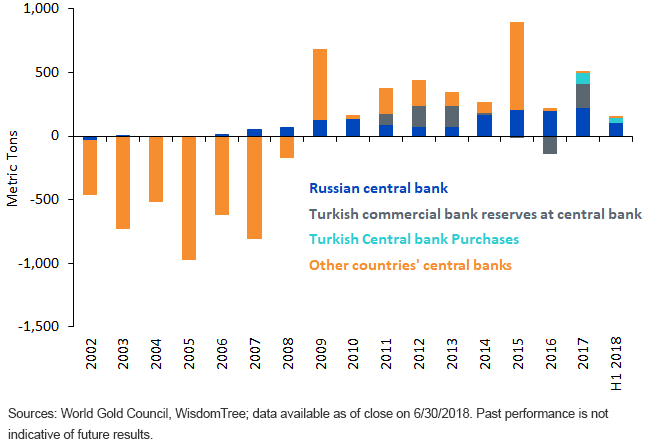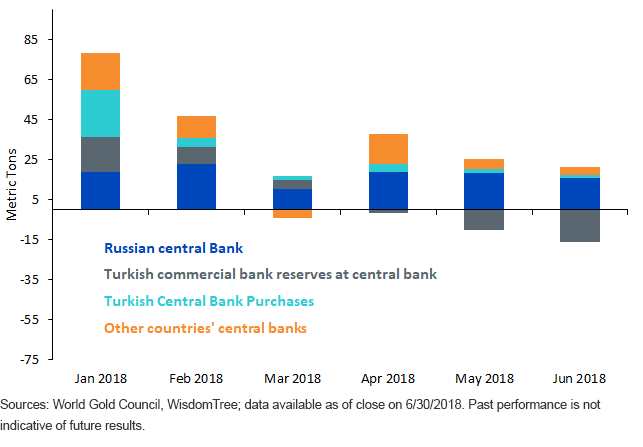Gold’s Initial Lackluster Response To Turkey Likely To Be A Red Herring
Turkey is going through an economic crisis―the lira has dropped to an all-time low, 34% over the week ending August 10. The euro also fell 2% over the week because some of the eurozone’s largest banks are lenders to Turkey, as highlighted by the European Central Bank’s financial watchdog department.
Gold traditionally has been seen as a safe-haven asset, often sought in times of investor anxiety. However, gold prices have declined .4% in the past week.1
Why Hasn’t Gold Reacted More Strongly?
Well, gold doesn’t always react quickly in times of stress. During the Argentine crisis, for example, the Minister of the Economy froze bank accounts on December 1, 2001 (a clear sign the writing was on the wall), and on December 23, 2001, the government defaulted on its sovereign debt. In the month of December 2001, gold rose only 1%. But in the first half of 2002, gold rose 15% as the ramifications of the Argentine crisis (and dot-com bubble issues) introduced a clear geopolitical premium into gold. This indicates that even as a crisis unfolds, it is not too late to build a hedge.
Turkish Central Bank: Largest Gold Accumulator in 2017
Gold’s relative underwhelming reaction to Turkey’s issues today may also be due to some of Turkey’s unique features.
The Central Bank of the Republic of Turkey (CBRT) is a large purchaser of gold. When defending the lira in this crisis, it may sell gold and investors may perceive this supply as price-negative. The CBRT bought 85.9 metric tons of gold in 2017, the second-largest gold purchases of any central bank next to the Central Bank of the Russian Federation (223.5 metric tons) in 2017.
Turkey has a somewhat unusual system in which commercial banks can use gold to meet reserve requirements with the central bank. In 2017, gold inflows into CBRT from commercial banks (held on reserve) amounted to 187.7 metric tons. Combining these two sources of flows to the CBRT, gold inflows into Turkey were the highest of any central bank.
Figure 1: Central Bank Gold Purchases (Annual)

How Long Is Gold’s Listlessness Likely to Last?
Part of the answer will relate to whether the stress in Turkey is transient or escalates. We can’t offer any meaningful precision here. However, if indeed the threat of Turkish gold being sold is weighing on its price, what could arrest that threat? CBRT could sell other currencies before touching gold, leaving little impact on gold supply. That could be a viable strategy for CBRT—that is, to punish currencies belonging to other countries rather than “stateless” gold.
Commercial banks appear to have reduced their gold held in reserves at the central bank in recent months. CBRT has seen an outflow from this source amounting to 27.5 metric tons between April and June 2018, wiping out most of the 30.7 metric tons of inflows from January to March 2018. If commercial banks and their customers withdraw more gold in a state of panic in the country, gold clearly will be playing its traditional role. This would be gold price-positive.
Figure 2: Central Bank Gold Purchases (Monthly)

There is also a chance that the government takes draconian action to prevent households hedging themselves with their gold. That is not without precedent. In 1933, the Roosevelt administration in the U.S. signed a presidential executive order “forbidding the Hoarding of gold coin, gold bullion, and gold certificates within the continental United States.” That ban on gold lasted until 1974. Such actions surely would make gold a coveted asset elsewhere.
The rhetoric of Turkey’s president Recep Tayyip Erdoğan already has been tilting in that direction. On August 10 , he stated, “If there is anyone who has dollars, euros or gold under the pillow, he should go and convert this at the bank.” Seizing assets is not an unthinkable step for a leader with power-hungry tendencies.
Conclusion
Gold does not always react quickly to stress events. Turkish-specific issues could be temporarily weighing on price more so than currency crises in countries where the central bank holds little gold. Today’s low price could offer investors an attractive entry point.
Disclaimer: Investors should carefully consider the investment objectives, risks, charges and expenses of the Funds before investing. U.S. investors only: To obtain a prospectus containing this ...
more



I love this article. Really good. Passed it onto my trading friends on Telegram. Lots of them trade in gold.